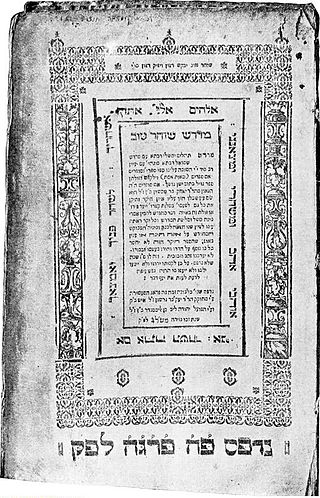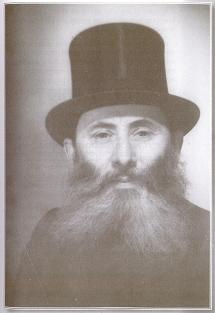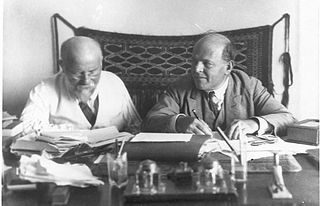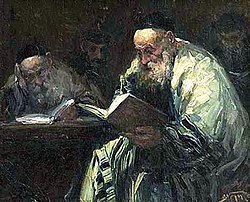Halakha, also transliterated as halacha, halakhah, and halocho, is the collective body of Jewish religious laws that are derived from the Written and Oral Torah. Halakha is based on biblical commandments (mitzvot), subsequent Talmudic and rabbinic laws, and the customs and traditions which were compiled in the many books such as the Shulchan Aruch. Halakha is often translated as "Jewish law", although a more literal translation of it might be "the way to behave" or "the way of walking". The word is derived from the root which means "to behave". Halakha not only guides religious practices and beliefs, it also guides numerous aspects of day-to-day life.

The Mishnah or the Mishna is the first major written collection of the Jewish oral traditions that are known as the Oral Torah. It is also the first major work of rabbinic literature. The Mishnah was redacted by Judah ha-Nasi probably in Beit Shearim or Sepphoris between the ending of the second century and the beginning of the 3rd century CE in a time when the persecution of Jews and the passage of time raised the possibility that the details of the oral traditions of the Pharisees from the Second Temple period would be forgotten.

Midrash is expansive Jewish Biblical exegesis using a rabbinic mode of interpretation prominent in the Talmud. The word itself means "textual interpretation", "study", or "exegesis", derived from the root verb darash (דָּרַשׁ), which means "resort to, seek, seek with care, enquire, require".

Rabbinic literature, in its broadest sense, is the entire spectrum of rabbinic writings throughout Jewish history. However, the term often refers specifically to literature from the Talmudic era, as opposed to medieval and modern rabbinic writings, and thus corresponds with the Hebrew term Sifrut Chazal. This more specific sense of "Rabbinic literature"—referring to the Talmudim, Midrashim, and related writings, but hardly ever to later texts—is how the term is generally intended when used in contemporary academic writing. The terms mefareshim and parshanim (commentaries/commentators) almost always refer to later, post-Talmudic writers of rabbinic glosses on Biblical and Talmudic texts.

The Gemara is an essential component of the Talmud, comprising a collection of rabbinical analyses and commentaries on the Mishnah and presented in 63 books. The term is derived from the Aramaic word גמרא and rooted in the Semitic word ג-מ-ר (gamar), which means "to finish" or "complete". Initially, the Gemara was transmitted orally and not permitted to be written down. However, after Judah the Prince compiled the Mishnah around 200 CE, rabbis from Babylonia and the Land of Israel extensively studied the work. Their discussions were eventually documented in a series of books, which would come to be known as the Gemara. The Gemara, when combined with the Mishnah, forms the full Talmud.

Torah study is the study of the Torah, Hebrew Bible, Talmud, responsa, rabbinic literature, and similar works, all of which are Judaism's religious texts. According to Rabbinic Judaism, the study is done for the purpose of the mitzvah ("commandment") of Torah study itself.

Midrash halakha was the ancient Judaic rabbinic method of Torah study that expounded upon the traditionally received 613 Mitzvot (commandments) by identifying their sources in the Hebrew Bible, and by interpreting these passages as proofs of the laws' authenticity.

Baraita designates a tradition in the Oral Torah of Rabbinical Judaism that is not incorporated in the Mishnah. Baraita thus refers to teachings "outside" of the six orders of the Mishnah. Originally, "Baraita" probably referred to teachings from schools outside the main Mishnaic-era yeshivas – although in later collections, individual barayata are often authored by sages of the Mishna (Tannaim).

Genesis Rabbah is a religious text from Judaism's classical period, probably written between AD 300 and 500 with some later additions. It is a midrash comprising a collection of ancient rabbinical homiletical interpretations of the Book of Genesis.
According to Rabbinic Judaism, the Oral Torah or Oral Law are statutes and legal interpretations that were not recorded in the Five Books of Moses, the Written Torah, and which are regarded by Orthodox Jews as prescriptive and given at the same time. This holistic Jewish code of conduct encompasses a wide swathe of rituals, worship practices, God–man and interpersonal relationships, from dietary laws to Sabbath and festival observance to marital relations, agricultural practices, and civil claims and damages.
This is a list of books by Jacob Neusner. Articles, reviews, etc. are not included here.

The Mekhilta of Rabbi Ishmael is midrash halakha to the Book of Exodus. The Aramaic title Mekhilta corresponds to the Mishnaic Hebrew term מדה middā "measure," "rule", and is used to denote a compilation of exegesis. Other important mekhiltas were those of Shimon bar Yochai and on Book of Deuteronomy. The latter work was also associated with Rabbi Ishmael's teachings.
Pardes (פרד"ס) is a Kabbalistic theory of Biblical exegesis first advanced by Moses de León, adapting the popular "fourfold" method of medieval Christianity. The term, sometimes also rendered PaRDeS, means "orchard" when taken literally, but is used in this context as a Hebrew acronym formed from the initials of the following four approaches:

Midrash Tanhuma, also known as Yelammedenu, is the name given to a homiletic midrash on the entire Torah, and it is known in several different versions or collections. Tanhuma bar Abba is not the author of the text but instead is a figure to whom traditions are frequently attributed to, though he may have preserved a collection of midrashim used by other midrash editors. The name Yelammedenu derives from the Hebrew phrase yelammedenu rabbenu, which initiates a typical textual unit in the text.

Midrash Tehillim, also known as Midrash Shocher Tov or the Midrash to Psalms, is an aggadic midrash to the Psalms.

Menachem Mendel Kasher was a Polish-born Israeli rabbi and prolific author who authored an encyclopedic work on the Torah entitled Torah Sheleimah.
Jewish folklore are legends, music, oral history, proverbs, jokes, popular beliefs, fairy tales, stories, tall tales, and customs that are the traditions of Judaism. Folktales are characterized by the presence of unusual personages, by the sudden transformation of men into beasts and vice versa, or by other unnatural incidents. A number of aggadic stories bear folktale characteristics, especially those relating to Og, King of Bashan, which have the same exaggerations as have the lügenmärchen of modern German folktales.

Sifrei Kodesh, commonly referred to as sefarim, or in its singular form, sefer, are books of Jewish religious literature and are viewed by religious Jews as sacred. These are generally works of Torah literature, i.e. Tanakh and all works that expound on it, including the Mishnah, Midrash, Talmud, and all works of halakha, Musar, Hasidism, Kabbalah, or machshavah. Historically, sifrei kodesh were generally written in Hebrew with some in Judeo-Aramaic or Arabic, although in recent years, thousands of titles in other languages, most notably English, were published. An alternative spelling for 'sefarim' is seforim.
The following outline is provided as an overview of and topical guide to Judaism:

Sefer HaAggadah is a compilation of Aggadot that was compiled and edited by Hayim Nahman Bialik and Yehoshua Hana Rawnitzki starting from 1903. Most of the sources included in Sefer HaAggadah come from the period of the Tannaim and the Amoraim. Bialik and Ravnitzky include aggadot from the Mishnah, the Babylonian Talmud, Jerusalem Talmud, Avot of Rabbi Natan, Mekhilta, Sifra, Sifre, Tosefta, Midrash Rabba, Midrash Tanhuma, Pirke De-Rabbi Eliezer, Sefer Yetzirah, Yalkut Shimoni, Alphabet of Sirach and others. Nahum Norbert Glatzer, Jewish literary scholar, theologian, and editor writes that Bialik's goal in compiling the Sefer HaAggadah was "…part of his attempt to popularize Hebrew classics." This mission is very much evident in Bialik's essay, Halakah and Aggadah where he expands on the roles of Halakah and Aggadah in reinventing or renewing a society's culture.









